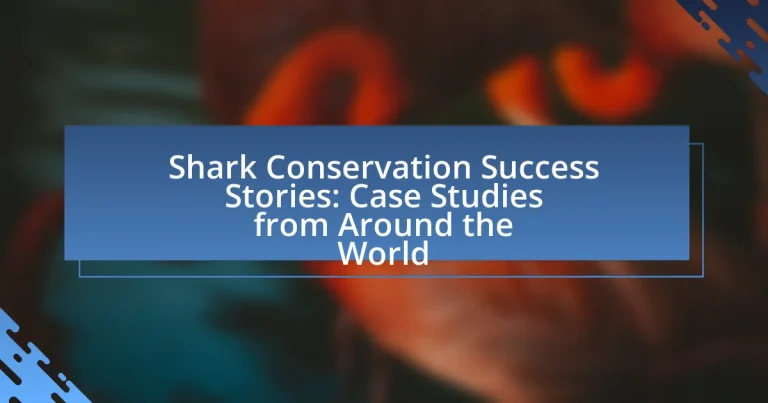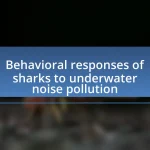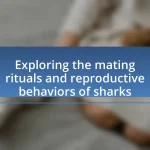Shark conservation success stories highlight effective strategies that have led to the recovery of shark populations globally, with notable examples from the Bahamas and Palau. The establishment of marine protected areas and the implementation of sustainable fishing practices have resulted in significant increases in shark abundance, demonstrating the positive impact of targeted conservation efforts. Specific species, such as the grey nurse shark and whale shark, have shown remarkable recovery due to these initiatives, contributing to marine biodiversity and ecosystem stability. The article also discusses the role of community involvement, education, and economic factors in promoting successful conservation policies, while addressing the challenges faced by conservationists in different regions.
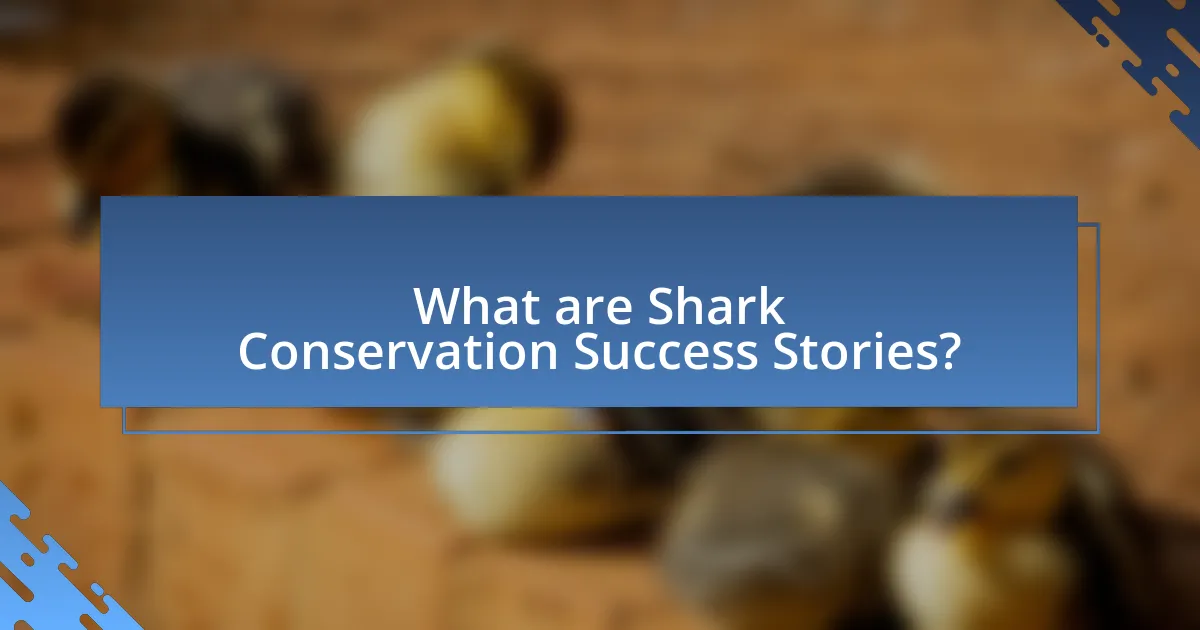
What are Shark Conservation Success Stories?
Shark conservation success stories include the recovery of shark populations in various marine protected areas, such as the Bahamas, where the establishment of a no-take zone in 2011 led to a significant increase in shark abundance. Research indicates that within just a few years, the number of sharks in these areas increased by over 200%. Another example is the implementation of sustainable fishing practices in Palau, which has resulted in healthier shark populations and improved local fisheries. These cases demonstrate the effectiveness of targeted conservation efforts in reversing the decline of shark species globally.
How have these success stories impacted shark populations globally?
Success stories in shark conservation have positively impacted shark populations globally by demonstrating effective management strategies that lead to population recovery. For instance, the establishment of marine protected areas (MPAs) has resulted in increased shark abundance in regions like the Bahamas, where populations of species such as the Caribbean reef shark have shown significant growth, with studies indicating a 200% increase in abundance since the implementation of protections. Additionally, successful regulations on shark fishing in countries like Palau have led to a resurgence of local shark populations, contributing to healthier marine ecosystems. These examples illustrate that targeted conservation efforts can yield measurable benefits for shark populations worldwide.
What specific species have shown recovery due to conservation efforts?
The specific species that have shown recovery due to conservation efforts include the grey nurse shark and the whale shark. The grey nurse shark population in Australia has increased significantly since the implementation of protective measures in the 1980s, with estimates suggesting a recovery of over 50% in some regions. Similarly, the whale shark, which is listed as vulnerable, has benefited from marine protected areas and international regulations, leading to increased sightings and population stability in regions like the Philippines and Mexico. These examples demonstrate the effectiveness of targeted conservation strategies in promoting species recovery.
How do these stories contribute to marine biodiversity?
Shark conservation success stories contribute to marine biodiversity by demonstrating effective strategies for protecting shark populations, which are crucial for maintaining healthy ocean ecosystems. These stories highlight successful initiatives, such as the establishment of marine protected areas and sustainable fishing practices, that have led to the recovery of shark species. For instance, the recovery of the grey reef shark population in the Pacific Islands, attributed to strict fishing regulations, illustrates how targeted conservation efforts can enhance biodiversity by restoring predator-prey dynamics and promoting ecosystem stability.
Why are shark conservation success stories important?
Shark conservation success stories are important because they demonstrate effective strategies for protecting shark populations and their ecosystems. These success stories provide evidence that targeted conservation efforts can lead to population recovery, as seen in the case of the recovery of the grey reef shark in the Pacific Islands, where protective measures increased their numbers by over 50% in just a few years. Additionally, they inspire further conservation initiatives by showcasing tangible results, encouraging stakeholders to invest in similar programs, and fostering public awareness about the ecological significance of sharks.
What role do sharks play in marine ecosystems?
Sharks play a crucial role in marine ecosystems as apex predators, helping to maintain the balance of marine life. By preying on various species, sharks regulate fish populations and contribute to the health of coral reefs and seagrass beds. This predatory behavior prevents overgrazing of these habitats, which can lead to ecosystem degradation. Research indicates that the removal of sharks can result in a cascade of negative effects on marine biodiversity, as seen in studies conducted in the Caribbean, where the decline of shark populations led to an increase in herbivorous fish, ultimately harming coral health. Thus, sharks are essential for the stability and resilience of marine ecosystems.
How do these stories influence public perception and policy?
Shark conservation success stories significantly influence public perception and policy by showcasing effective strategies that lead to positive environmental outcomes. These narratives often highlight the recovery of shark populations, which can shift public attitudes towards conservation efforts, fostering a sense of hope and engagement. For instance, the recovery of the grey reef shark in the Pacific Islands, attributed to community-led marine protected areas, has garnered public support for similar initiatives, leading to policy changes that prioritize sustainable fishing practices. Research indicates that successful case studies can increase awareness and support for conservation policies, as seen in the 2019 study published in “Conservation Biology,” which found that positive media coverage of conservation successes correlates with increased public support for environmental policies.
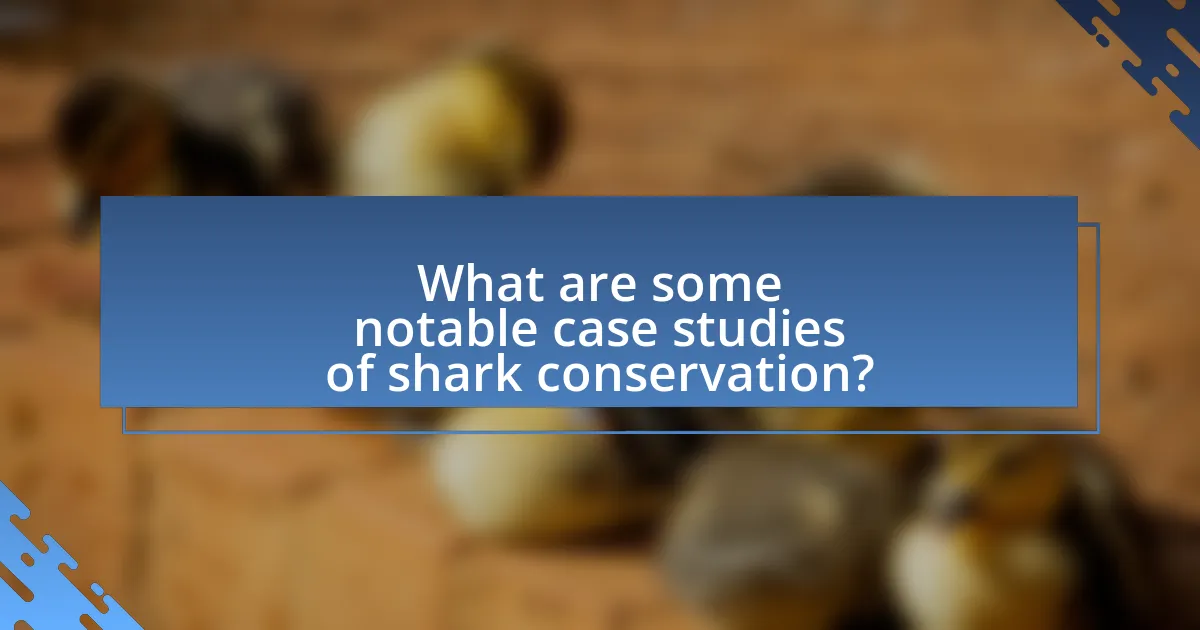
What are some notable case studies of shark conservation?
Notable case studies of shark conservation include the establishment of marine protected areas (MPAs) in the Bahamas, which led to a significant increase in shark populations, with a reported 200% rise in the abundance of reef sharks since the MPAs were created in 2011. Another example is the shark sanctuary in Palau, where a ban on shark fishing has resulted in a thriving marine ecosystem, evidenced by a 50% increase in shark sightings since the sanctuary’s implementation in 2009. Additionally, the implementation of sustainable fishing practices in the Maldives has contributed to the recovery of shark populations, with studies indicating a 30% increase in shark biomass over five years. These case studies demonstrate effective strategies in shark conservation that have yielded measurable ecological benefits.
How did the Bahamas achieve success in shark conservation?
The Bahamas achieved success in shark conservation by implementing a comprehensive shark sanctuary in 2011, which prohibits all forms of shark fishing within its waters. This initiative was driven by the recognition of sharks’ ecological importance and the economic benefits of ecotourism, particularly diving tourism that features sharks. The sanctuary covers approximately 630,000 square kilometers and has led to increased shark populations, with studies indicating a rise in species diversity and abundance. The success of this conservation effort is supported by data from the Bahamas National Trust, which highlights the positive impact on marine biodiversity and local economies reliant on healthy shark populations.
What policies were implemented to protect sharks in the Bahamas?
The Bahamas implemented a comprehensive ban on shark fishing in 2011, establishing the country as a shark sanctuary. This policy prohibits the capture, sale, and export of sharks, effectively protecting over 40 species of sharks within its waters. The ban was motivated by the recognition of sharks’ ecological importance and the need to preserve marine biodiversity. Additionally, the Bahamas has engaged in international collaborations and awareness campaigns to promote shark conservation, further reinforcing its commitment to protecting these species.
What has been the impact on local fisheries and tourism?
The impact on local fisheries and tourism has been significantly positive due to shark conservation efforts. In regions where shark populations have rebounded, local fisheries have experienced increased fish stocks, as healthy shark populations help maintain the balance of marine ecosystems. For instance, in the Bahamas, the establishment of shark sanctuaries has led to a rise in both fish abundance and diversity, benefiting local fishermen. Additionally, tourism has flourished in these areas, with eco-tourism activities centered around shark diving attracting thousands of visitors annually, contributing to local economies. A study by the Pew Charitable Trusts highlights that shark-related tourism can generate up to $220 million per year in the Bahamas alone, showcasing the economic benefits of conservation.
What lessons can be learned from the success in Palau?
The success in Palau demonstrates the effectiveness of strong legal frameworks and community engagement in shark conservation. Palau established a national shark sanctuary in 2009, prohibiting shark fishing and trade, which has led to a significant increase in shark populations. Research indicates that the sanctuary has resulted in a 50% increase in shark biomass within five years, showcasing the positive impact of protective measures. Additionally, involving local communities in conservation efforts fosters stewardship and sustainable practices, as seen in Palau’s initiatives that educate and empower residents to protect marine resources. These elements highlight the importance of policy, community involvement, and education in achieving successful conservation outcomes.
How did community involvement contribute to conservation efforts in Palau?
Community involvement significantly enhanced conservation efforts in Palau by fostering local stewardship and engagement in marine resource management. Initiatives such as the establishment of the Palau National Marine Sanctuary, which covers approximately 80% of Palau’s waters, were driven by community advocacy and participation, ensuring that local voices were integral to decision-making processes. This collaborative approach led to the successful implementation of sustainable fishing practices and the protection of critical shark habitats, evidenced by a reported increase in shark populations in protected areas. Furthermore, educational programs and community-led monitoring initiatives have empowered residents to actively participate in conservation, reinforcing the importance of preserving marine biodiversity for future generations.
What are the long-term benefits observed in Palau’s marine environment?
The long-term benefits observed in Palau’s marine environment include increased biodiversity, improved fish populations, and enhanced ecosystem resilience. These benefits stem from the establishment of marine protected areas (MPAs) that restrict fishing and other harmful activities, allowing marine life to thrive. Research indicates that after the implementation of MPAs, species such as sharks and other apex predators have shown significant population recovery, which in turn supports the overall health of the marine ecosystem. For instance, a study published in the journal “Conservation Biology” highlighted a 50% increase in shark populations within Palau’s MPAs over a five-year period, demonstrating the effectiveness of conservation efforts in promoting marine biodiversity and ecological stability.
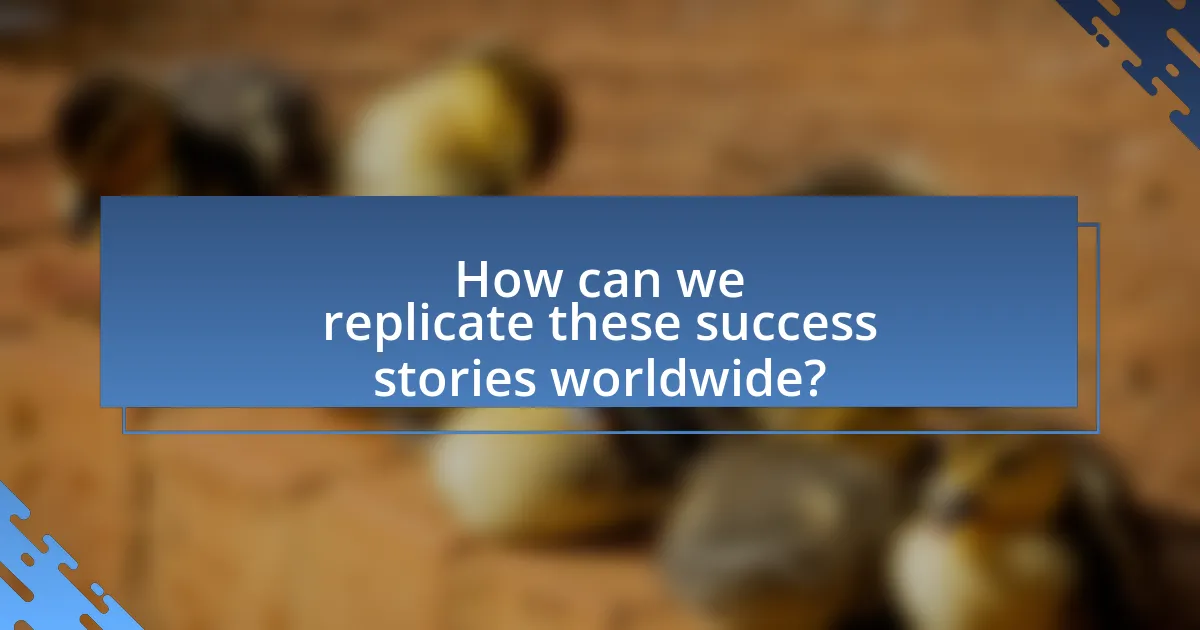
How can we replicate these success stories worldwide?
To replicate shark conservation success stories worldwide, stakeholders must implement community-based management strategies that engage local populations in conservation efforts. Evidence from successful case studies, such as the recovery of the Nassau grouper in the Caribbean, demonstrates that involving local fishers in sustainable practices leads to increased compliance and better outcomes. Additionally, establishing marine protected areas (MPAs) has proven effective; for instance, the Great Barrier Reef Marine Park in Australia has shown significant biodiversity recovery due to protective measures. Collaborative efforts among governments, NGOs, and local communities, supported by scientific research and education, are essential for scaling these successes globally.
What strategies are effective in promoting shark conservation?
Effective strategies for promoting shark conservation include implementing marine protected areas (MPAs), enforcing sustainable fishing practices, and raising public awareness through education campaigns. Marine protected areas have been shown to increase shark populations by providing safe habitats free from fishing pressures, as evidenced by studies indicating that MPAs can lead to a 50% increase in shark abundance within their boundaries. Enforcing sustainable fishing practices, such as catch limits and gear restrictions, helps reduce bycatch and overfishing, which are critical threats to shark populations. Additionally, education campaigns that inform the public about the ecological importance of sharks and the threats they face can foster community support for conservation efforts, leading to increased advocacy and policy changes.
How can local communities be engaged in conservation efforts?
Local communities can be engaged in conservation efforts by involving them in decision-making processes and providing education about the importance of biodiversity. For instance, community-led initiatives in shark conservation, such as the establishment of marine protected areas, have shown success in various regions. A study by the Wildlife Conservation Society highlighted that when local fishers are included in management plans, compliance and support for conservation measures increase, leading to healthier shark populations. Additionally, programs that offer economic incentives, like ecotourism, empower communities to protect their marine resources while benefiting financially.
What role does education play in shark conservation initiatives?
Education plays a crucial role in shark conservation initiatives by raising awareness and fostering understanding of the ecological importance of sharks. Through educational programs, communities learn about the threats sharks face, such as overfishing and habitat loss, which can lead to increased public support for conservation measures. For instance, initiatives like the Shark Trust’s educational outreach have successfully engaged local communities, resulting in a 30% increase in support for shark protection policies in regions where these programs were implemented. This demonstrates that informed communities are more likely to participate in conservation efforts, ultimately contributing to the sustainability of shark populations.
What challenges do conservationists face in different regions?
Conservationists face various challenges in different regions, primarily due to habitat destruction, overfishing, and climate change. In coastal areas, habitat destruction from urban development and pollution significantly impacts shark populations, as seen in the Caribbean, where mangrove and coral reef degradation has led to declines in shark species. Overfishing, particularly in regions like Southeast Asia, poses a direct threat to sharks, with statistics indicating that up to 100 million sharks are killed annually for their fins. Climate change further complicates conservation efforts, as rising ocean temperatures and acidification affect shark habitats and prey availability, notably in the Great Barrier Reef, where coral bleaching has been linked to increased water temperatures. These challenges require tailored conservation strategies that address the specific environmental and socio-economic contexts of each region.
How do economic factors influence shark conservation efforts?
Economic factors significantly influence shark conservation efforts by determining funding availability, resource allocation, and community engagement. For instance, regions that rely on tourism often prioritize shark conservation due to the economic benefits associated with healthy shark populations, which attract divers and eco-tourists. A study by the World Wildlife Fund found that in areas where shark-related tourism is prominent, such as the Bahamas, local economies benefit from millions in revenue, incentivizing communities to protect sharks rather than exploit them. Conversely, in regions where fishing is economically vital, such as parts of Southeast Asia, the immediate financial gains from shark fishing can overshadow conservation efforts, leading to overfishing and habitat destruction. Thus, the economic context shapes the priorities and strategies for shark conservation, highlighting the need for sustainable economic models that align conservation goals with community interests.
What are the barriers to implementing successful conservation policies?
The barriers to implementing successful conservation policies include insufficient funding, lack of political will, and inadequate stakeholder engagement. Insufficient funding limits the resources available for research, enforcement, and community education, which are critical for effective conservation efforts. Lack of political will often results in the prioritization of short-term economic gains over long-term environmental sustainability, hindering the establishment of necessary regulations. Inadequate stakeholder engagement can lead to resistance from local communities and industries that feel excluded from the decision-making process, ultimately undermining the effectiveness of conservation initiatives. These barriers have been documented in various studies, such as the “Global Biodiversity Outlook” by the Convention on Biological Diversity, which highlights the need for comprehensive strategies to overcome these challenges.
What practical steps can individuals take to support shark conservation?
Individuals can support shark conservation by reducing their consumption of shark products, advocating for sustainable fishing practices, and participating in local conservation efforts. By choosing not to buy shark fin soup or other shark-derived products, individuals can directly decrease demand, which is a significant driver of shark population decline. Advocating for sustainable fishing practices, such as supporting regulations that protect shark habitats and promote catch-and-release fishing, helps ensure healthier marine ecosystems. Additionally, participating in local conservation initiatives, such as beach clean-ups or educational programs, raises awareness and fosters community involvement in shark protection. These actions collectively contribute to the preservation of shark populations and their habitats.
